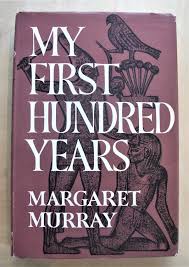Murray, Margaret. My First Hundred Years. London: William Kimber 1963. Print.
I always think that an autobiography should begin with some account of the forebears and immediate family of the writer so that one can understand some of the early influences which have affected the writer and have helped to make him what he is. My ancestral tree is a very short one going back to only one set of great-great-grandparents, about two hundred. I have quite undistinguished lineage...
Description:
And she did not disappoint. Her memory is remarkable for a centenarian (or for anyone for that matter), and her writing style exquisite: free-flowing, descriptive, chatty, and full of interesting details of life as a woman archeologist in that very new field.
Born and raised in Calcutta, India, to wealthy parents, Murray was educated in London where she became interested in archeology, a class she only had taken on a whim. The professor, Sir William Petrie, a pioneer of the new field of Egyptology, took Murray under his wing. She edited and illustrated his writings, eventually accompanying Petrie to Egypt as a site nurse. There she absorbed his methods and discoveries at various sites and soon grew to be a qualified archeologist in her own right. She became a teacher of Egyptian linguists and translator of hieroglyphics at the University of London.
What I loved about her recollections was her attention to details and personal feelings. She related memories of the visit to India of the Prince of Wales, where attending Maharajahs competed to out-dazzle each other in their dress. For example, the Maharajah of Patiala wore a coat with "fronts, color, cuffs, and hem embroidered with gold thread and peals, [and] round his neck he wore at least four graduated rows of diamonds, the longest reaching nearly to his waist."
Her early home life included eating with small silver cutlery (larger ones were never adopted by her father) and, at the end of the meal, having the visiting servants of the invited diners carefully frisked for any valuable spoons they might have pocketed. Her mother encouraged a broad education without focus on a single subject, a technique that so limited Murray's brilliant sister Mary she never could focus on one skill and thus was unable to rise to her potential in piano, mathematics, or language. Murray also recalled tales of the horrific Indian Mutiny as related by her grandmother.
As an Egyptologist, Murray translated inscriptions found in tombs, uncovered a major temple to Osiris constructed by the Pharaoh Seti I, and was the first woman to unwrap an Egyptian mummy.
Murray later became an ardent supporter of women rights and suffrage, including pushing for acceptance of women in academia and archeology. She expanded her on-going interest in folklore to include witchcraft, a topic on which she wrote many books as well as the entry for the Encyclopedia Britannica on that topic.
Hers was an amazing life, one that is now available to lucky readers to delve into the world of nineteenth century India and twentieth century (and centuries-earlier) Egypt. I was totally fascinated to "listen" to her recall story after story, detail after detail, of the worlds she knew and was eager to share. A lively, lovely story of an important woman's world and achievements.
[If this book interests you, be sure to check out:]
Carefully details the lives of those people from the general public who contributed words, definitions, and sources for terms to be included in the original Oxford Dictionary. (previously reviewed here)
Happy reading.
Fred
Click here to browse over 465 more book recommendations by subject or title
(and read the introduction to The First Sentence Reader).


